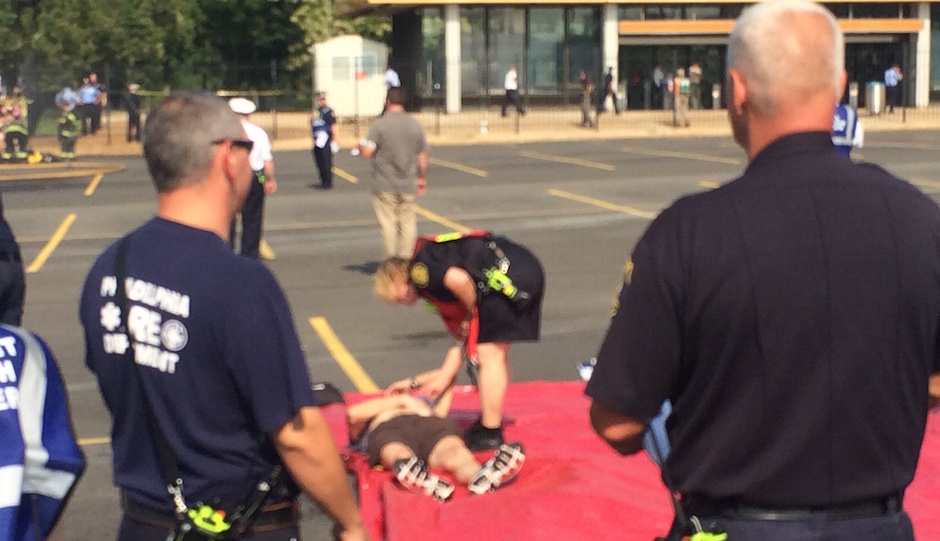In Advance of Pope Visit, Philly Demonstrates “Mass Casualty” Response
What would happen if a terrorist detonated a chemical weapon in Philadelphia? It’s a terrifying thought but, with the pope’s visit just two months away, it’s a scenario that authorities are contemplating even more closely than before. And on Wednesday morning, scores of police, fire and other emergency personnel participated in a training exercise in South Philadelphia, demonstrating how they would respond in a “mass casualty” incident.
Although the imagined incident was supposed to be a chemical weapon explosion underground on a busy weekend night — according to an official from the city’s Office of Emergency Management, we were to imagine a Phillies game at Citizens Bank Park and a sold out Zac Brown Band concert at Wells Fargo Center, both of which were about to end — the city chose a quiet Wednesday morning when both venues were empty. Just after 9 a.m., a commotion began at the southernmost portal to SEPTA’s AT&T station, just south of Pattison Avenue and across from the Wells Fargo Center, Lincoln Financial Field, Citizens Bank Park, and XFinity Live.
A young man came running out of the station screaming, and other “victims,” all played by volunteers, followed. Soon, the voices of emergency dispatchers were heard over radios, referring first to a “major incident” and the “report of an explosion” at Broad Street and Pattison Avenue and quickly upgrading it to a “mass casualty incident.” There was talk of some sort of unidentified chemical agent being released in the explosion.
Fire trucks and other rescue vehicles poured into the area surrounding the station. There were your typical fire engines. There was the Philadelphia Police Department’s Major Incident Response Team truck. There were the Philadelphia Fire Department’s Hazmat and Hazardous Material Command Unit trucks. The list goes on.
Many of the emergency workers wore vests denoting their roles: Transportation Group Supervisor, Treatment Dispatch Manager and Water Operations Officer, to name a few. “Where’s your vest?” shouted one official at a worker not wearing one. He quickly pulled out his vest and put it on.
But mostly, things moved pretty slowly for a mass casualty training exercise. The blazing sun and air temperature made for awful conditions on the blacktop that served as the decontamination area, but that didn’t stop the firefighters from showing up in their full, sweltering uniforms. Some of those portraying the victims wore board shorts and teeny bikinis. And everyone moved along at a languid dead-of-summer pace — not with the sense of urgency that one might expect to come during one of the city’s worst moments. Of course, this was more a drill for workers to go through the actual motions and have an idea of protocols and procedures than it was a reenactment of the type you’d see on a cable show about mass catastrophes.
As a first step in the decontamination process, the fire department set up two trucks side-by-side with a passageway between them and two large sprays of water, creating a water park-like tunnel designed to get contaminants off the clothes and skin, as seen in the photo above. Some participants walked through, while others were pushed through on gurneys, and a spokesperson for OEM said that in a real-life situation, the victims would have to be stripped of all clothing and go through decontamination naked. One observer complained that the water spray was a “giant waste of water,” and an emergency worker was overheard saying, “I’d sure like to run through that right about now.”
Then the victims were divided into three groups, depending on how severe their injuries were. The worst cases — Priority 1 — were moved to a red tarp, while the most minor injuries — Priority 3 — sat on a green tarp awaiting treatment. The lesser affected victims complained of headaches and dizziness.
The last victim through was OEM director Samantha Phillips, who said she wanted to play that role so she could have some idea what the public would experience. Later, Phillips told reporters that there was talk of postponing the drill due to the heat. “But there really wasn’t time,” she said, citing the pope’s rapidly approaching visit.
While previous emergency exercises have focused on active shooters and other potential mass casualty incidents, Phillips explained that this was the city’s first mass decontamination exercise, the results of many months of planning, workshopping, and a so-called tabletop exercise. She noted that it’s not all about saving lives — it’s also about getting a Rolex back to the right victim after he is decontaminated and released. There are many pieces to the puzzle.
Phillips considered Wednesday’s exercise a success. But given the fact that rescue workers didn’t have to deal with swarms of police investigators, Homeland Security, the FBI and others who would be intent on finding a suspect, huge crowds wanting to get out of the venues, or any actual chaos, for that matter — there were even free pretzels from Philly Pretzel Factory, water from Wawa, and something in a crockpot — there’s no telling what their actual performance would be like. And we sure hope we never have to find out.
Follow @VictorFiorillo on Twitter.




